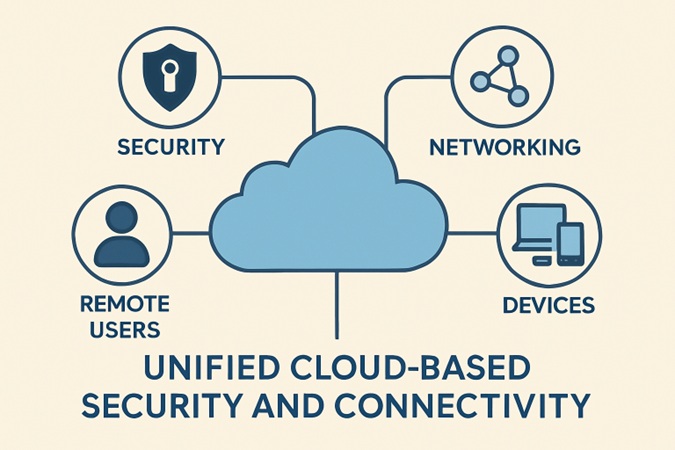- SASE integrates networking and security into a unified, cloud-native service.
- It enhances security for remote and hybrid workforces by implementing zero-trust principles.
- SASE offers scalability and flexibility, supporting business growth and digital transformation.
- The need for improved security, simplified management, and cost efficiency drives SASE adoption.
Introduction
As organizations accelerate their digital transformation, the need for agile, secure, and scalable connectivity has never been greater. Businesses are re-evaluating their traditional network and security architectures to keep pace with evolving threats and the distributed nature of modern workplaces. The rise of Secure Access Service Edge (SASE network security) represents a major shift, merging network and security capabilities into a single, cloud-delivered platform.
By embracing SASE, organizations can unify their networking and security into a more streamlined, flexible, and robust framework. This new model is not just about protection, as it’s about enabling businesses to thrive in the era of cloud, mobility, and ever-changing cyber risks.
Understanding SASE
SASE, first described by Gartner in 2019, combines wide-area networking (WAN) with a comprehensive suite of security tools, including cloud access security brokers (CASB), secure web gateways (SWG), firewall-as-a-service (FWaaS), and zero-trust network access (ZTNA). Delivered through the cloud, these capabilities ensure that network traffic, regardless of user location or device, benefits from consistent policy enforcement and advanced threat protection.
The consolidation of these services is a direct response to the shortcomings of legacy, on-premises security models, which struggle to protect users accessing business applications from remote or mobile environments. With SASE, organizations can deliver reliable, secure access to their digital assets, meeting the demands of today’s decentralized workforce. For organizations moving to the cloud, adopting a unified approach such as SASE also facilitates compliance, visibility, and control. Businesses no longer have to manage patchwork solutions; instead, they gain a holistic platform that manages access and safeguards critical data.

Enhancing Security For Remote & Hybrid Workforces
The explosion of remote and hybrid work has shattered the concept of a fixed network perimeter. Employees now have access to business resources from various locations and devices, vastly increasing the potential attack surface. Traditional perimeter-based security can’t keep pace with this distributed model, exposing organizations to heightened risks. SASE addresses these challenges by operationalizing zero-trust principles, which assume that no user or device should be granted access until thoroughly verified. Every connection is treated as untrusted until authenticated, and continuous monitoring ensures ongoing compliance. This strategy reduces the risk of unauthorized access and limits lateral movement in the event of a breach. Compa is adopting SASE and reporting improvements in its security posture, especially in sensitive industries under regulatory pressure. Tools such as identity-based access, granular policy controls, and real-time threat intelligence ensure threats are detected and mitigated early, wherever users log in.
Scalability & Flexibility
The ability to rapidly scale network infrastructure has become a competitive differentiator as companies expand globally and integrate new cloud applications. SASE’s cloud-native architecture enables businesses to add users, locations, and devices without investing in additional hardware or complicated rollouts.
This flexibility is particularly valuable for organizations pursuing digital transformation or mergers and acquisitions, where seamless onboarding is critical. Instead of lengthy deployments or piecemeal upgrades, IT leaders can use SASE to provide advanced security and optimized connectivity where and when it’s needed.
As cloud apps and IoT initiatives multiply, SASE’s agility allows businesses to keep up with evolving tech landscapes. For an in-depth look at SASE’s technical benefits and trends, check out this insightful resource from TechTarget.
Simplified Management & Cost Efficiency
Juggling multiple vendors and solutions for networking and security can lead to massive operational overhead, inconsistent policies, and spiraling costs. SASE streamlines this complexity by consolidating core functions into a single, orchestrated platform, enabling easier management and greater operational efficiency.
Centralized policy management enables IT teams to set and enforce rules worldwide through a single interface, accelerating response to new threats or business changes. More automation and visibility lead to fewer misconfigurations, faster troubleshooting, and reduced resources needed for ongoing maintenance.
Cost efficiencies also come from reduced spending on legacy hardware, minimized travel for distributed IT teams, and consolidated licensing. It’s a win-win, as businesses can reinvest savings into growth or innovation initiatives.
Driving Factors For SASE Adoption
- Remote Work: Securing employee access beyond the office has driven demand for SASE solutions, which support anywhere, anytime connectivity.
- Cloud Adoption: As more companies rely on SaaS and cloud-hosted infrastructure, SASE ensures secure, optimized access for all users, regardless of physical location.
- Cybersecurity Threats: The rising sophistication of cyberattacks requires integrated, intelligent security that adapts to new risks, making SASE a critical investment for future-proofing business operations.
Real-World Applications
Across industries like finance, healthcare, and retail, SASE solutions are being adopted to accelerate digital transformation and safeguard customer data. Businesses undergoing mergers or opening new locations leverage SASE to connect disparate IT environments and enforce uniform security standards instantly.
For example, global enterprises are now equipping their remote workers with fast, protected access to cloud apps and intranets, markedly improving user experience while meeting strict compliance obligations. Additionally, organizations with field operations or supply chains spanning continents use SASE to lower latency and boost productivity, all without sacrificing security.
Conclusion
Secure Access Service Edge is steering the future of business connectivity, merging the essential pillars of networking and security into a single, future-ready solution. By empowering organizations with scalable, flexible, and cost-effective infrastructure, SASE not only protects data and productivity but also lays the foundation for continued business innovation. As companies navigate emerging threats and increasingly distributed work models, SASE offers a path toward secure, efficient, and resilient operations for the digital era.
